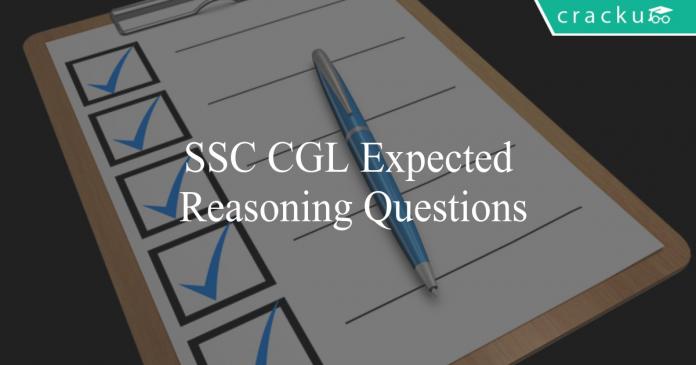SSC CGL Expected Reasoning Questions 2019
Download SSC CGL Expected Reasoning Questions 2019 PDF based on previous papers very useful for SSC CGL exams. 20 Expected Reasoning Questions for SSC exams.
Download SSC CGL Expected Reasoning Questions
10 SSC CGL Mocks – Just Rs. 117
Question 1: If a mirror is placed on the line AB, then which of the answer figures is the right image of the given figure?

a)

b)

c)

d)

Question 2: If a mirror is placed on the line AB, then which of the answer figures is the right image of the given figure?

a)

b)

c)

d)

Question 3: A piece of paper is folded and punched as shown below in the question figures. From the given answer figures, indicate how it will appear when opened?

a)

b)

c)

d)

Question 4: A piece of paper is folded and punched as shown below in the question figures. From the given answer figures, indicate how it will appear when opened?

a)

b)

c)

d)

Question 5: From the given answer figures, select the one in which the question figure is hidden/embedded.

a)

b)

c)

d)

SSC CGL Previous Papers Download PDF
Question 6: From the given answer figures, select the one in which the question figure is hidden/embedded.
a)

b)

c)

d)

Question 7: Which answer figure will complete the pattern in the question figure ?

a)

b)

c)

d)

Question 8: Which answer figure will complete the pattern in the question figure ?

a)

b)

c)

d)

Question 9: In the given figure, how many colour televisions are not wide?

a) 72
b) 18
c) 43
d) 61
Question 10: In the given figure, how many big bottles are not blue?

a) 37
b) 115
c) 152
d) 89
18000+ Questions – Free SSC Study Material
Question 11: Identify the diagram that best represents the relationship among the given classes.
Yellow,Vegetables,Red Blood
a)

b)

c)

d)

Question 12: Three positions of a cube are shown below.

Which letters will come on two faces marked ‘1 and 2’ ?

a) U and P
b) Q and R
c) P and S
d) R and P
Question 13: From the given options, which answer figure can be formed by folding the figure given in the question ?

a)

b)

c)

d)

Question 14: In the following question below are given some statements followed by some Conclusions. Taking the given statements to be true even if they seem to be at variance from commonly known facts, read all the Conclusions and then decide which of the given Conclusion logically follows the given statements.
Statements:
I. All pages are yellow.
II. All yellow are newspapers
III. Some newspapers are national.
Conclusions:
I. Some national are yellow.
II. Some newspapers are pages.
III. No page is national.
a) Only Conclusion I and II follow
b) Only Conclusion I and III follow
c) Only Conclusion II follow
d) Only Conclusion III follow
Question 15: In the following question below are given some statements followed by some Conclusions. Taking the given statements to be true even if they seem to be at variance from commonly known facts, read all the Conclusions and then decide which of the given Conclusion logically follows the given statements.
Statements:
I. Some clothes are white.
II. Some white are flags.
III. No flag is straight.
Conclusions:
I. No cloth is straight.
II. Some white are straight
III. Some flags are clothes.
a) Only Conclusion I follows
b) Only Conclusion II follows
c) Only Conclusion III follows
d) None follows
Question 16: How many triangles are there in the given figure?

a) 12
b) 11
c) 10
d) 15
Question 17: How many rectangles are there in the given figure?

a) 19
b) 16
c) 17
d) 18
Question 18: In the following question, select the number which can be placed at the sign of question mark(?) from the given alternatives.

a) 105
b) 95
c) 190
d) 120
Question 19: In the following question, select the number which can be placed at the sign of question mark (?) from the given alternatives.

a) 84
b) 91
c) 83
d) 95
Question 20: If 7 (110) 4 and 19 (930), 12, then what is the value of ‘A’ in 16 (A) 9 ?
a) 580
b) 600
c) 640
d) 700
Answers & Solutions:
1) Answer (A)
2) Answer (C)
A vertical mirror is placed, so the object on the left will appear right in reverse position and vice-versa.
So the arrow in the middle will be reversed and now point leftwards, thus the first option will be eliminated.
Also, in the question figure, the two dots are at the extreme ends, which will remain as it is, hence third option is the right image.
=> Ans – (C)
3) Answer (A)
4) Answer (A)
5) Answer (D)
6) Answer (D)
7) Answer (D)
The question figure will be completed by :

=> Ans – (D)
8) Answer (C)
In the question figure, the arrows are forming a clock wise pattern, thus the arrow in the missing figure must point towards left, hence first two options are eliminated.
Also, to form the complete diagonal, we need to have the black triangle at the top left side, hence third figure is the required answer.
=> Ans – (C)
9) Answer (B)

Colour televisions that are not wide = 18
=> Ans – (B)
10) Answer (A)
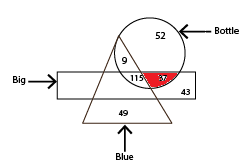
Big bottles that are not blue = 37
=> Ans – (A)
11) Answer (C)
Some vegetables are yellow in colour, but red blood is completely different from them, hence the venn diagram that best describes above relationship is :

=> Ans – (C)
12) Answer (B)
13) Answer (A)
14) Answer (C)
The venn diagram for above statements is :
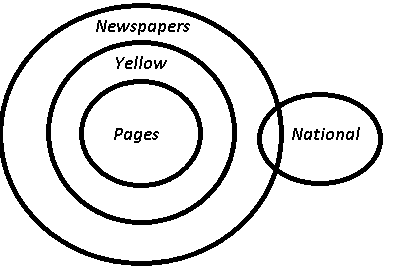
Conclusions:
I. Some national are yellow = false
II. Some newspapers are pages = true
III. No page is national = may or may not be true
Thus, only Conclusion II follow.
=> Ans – (C)
15) Answer (D)
The venn diagram for above statements is :
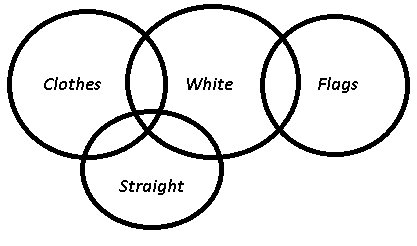
Conclusions:
I. No cloth is straight = false
II. Some white are straight = may or may not be true
III. Some flags are clothes = false
Thus, none follows.
=> Ans – (D)
16) Answer (B)
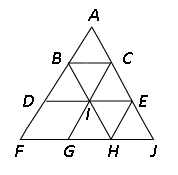
Small triangles = ABC, BID, BCI, CIE, GIH, HIE, JEH
Big triangles (having 3 or 4 triangles) = ADE, BFH, CGJ
Biggest triangle = AFJ
=> Total triangles = 11
=> Ans – (B)
17) Answer (A)
18) Answer (B)
In the first column, the product of the first two numbers is divided by the last number to get the number in the second column.
Eg :- $\frac{4\times9}{6}=6$
and $\frac{12\times7}{4}=21$
Similarly, $\frac{15\times19}{3}=95$
=> Ans – (B)
19) Answer (A)
The pattern followed for the diagonally opposite numbers are = $x\times n+(n-1)$, where $n$ is a natural number starting from 2.
(1,3) = $1\times2+(2-1)=2+1=3$
(4,14) = $4\times3+(3-1)=12+2=14$
(9,39) = $9\times4+(4-1)=36+3=39$
Similarly, $16\times5+(5-1)=80+4=84$
=> Ans – (A)
20) Answer (B)
The pattern followed is that for the numbers : $x(z)y$, $z=(x+y)\times(x+y-1)$
Eg :- 7 (110) 4 => Here $7+4=11\equiv(11\times10)=110$
and 19 (930) 12 => Here $19+12=31\equiv(31\times30)=930$
Similarly, 16 (A) 9 => Here $16+9=25$
=> $A=25\times24=600$
=> Ans – (B)
We hope this Expected Reasoning questions for SSC Exam will be highly useful for your preparation.


